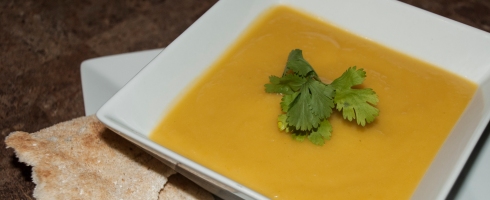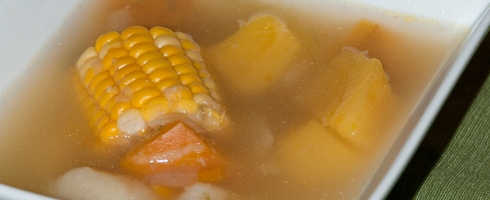By now you must know how much I love soups and creams. I have given you the Apio Soup and the chicken soup recipes so far, but there are plenty more Venezuelan soup and cream recipes to come. Today I want to share with you another very popular Venezuelan creamy soup, the Crema de Auyama. The Auyama, pronounced awˈʝa.ma, is technically a fruit because it contains the seeds of the plant inside. However, most people consider it a vegetable. It most resembles the squash and pumpkin types. In Venezuela it is used in most soup preparations like Sancochos and it is also used on its own to create this cream. However, it is also used to create sweet recipes such as bread and cakes.
The Auyama is easy to cultivate and therefore it is sold in large quantities and at a cheaper price than other vegetables. It is rich in potassium, calcium, vitamin A, and fiber. It is also low in calories because it is mostly made out of water, but it is very tasty. It is believed that because it was easily cultivated, Europeans used it as fodder to feed their animals. Each plant can bear up to 8 fruits and it only takes 140 days to harvest. In Venezuela it is available all year long. However, the Auyama harvested in summer has a sandy-textured pulp and it works best for pasta fillings or cakes. On the other hand, the Auyama harvested in winter is the one that is best for creams and soups, because the pulp is more fibrous and pale, and it has more water content.
Here in the US, the type of pumpkin or squash that I believe to be the closest to the authentic Venezuelan Auyama is sold as Squash Calabaza. I have bought it at Publix and Sedano’s in big chunks (they cut it and sell each individual piece in cling wrap), I have also bought one at Wal-Mart sold as a whole (the whole Calabaza), but I think the ones that come cut in chunks are the ones that most resemble the Auyama taste. The Venezuelan Auyama belongs to the Curcubitaceae family, and the curcubita genre, in the varieties called máxima, moschata, mixta and pepo. Its size is large and it comes in different shapes and sizes, with skin that varies from green to yellow to orange, it can be either smooth or corrugated, and the pulp varies from pale yellow to bright yellow-orange. The taste also varies from very sweet to not so sweet. This is probably why it has been hard for me to find one that truly matches the Venezuelan Auyama taste.
This particular recipe is my sister’s very own recipe, so it is not a traditional recipe, but it is very close to it. My sister, Mariale Ojeda, a.k.a. The Soup Queen as we call her around here, is an expert at making delicious soups for me, the soup lover. This post was created by her, the recipe, the cooking and the photos are all hers. I have to say special thanks to her for all the soups she has been cooking for us lately and for this amazing recipe and post she created as a featured writer of Venezuelan Cooking.
What you need:
– 4 lbs. Auyama (Squash Calabaza)
– 6½ Cups Chicken Broth or Chicken Bouillon (enough to cover all the Auyama)
– 5 to 8 Stems of Cilantro
– 1 Teaspoon Minced Garlic
– ½ Chopped Onion
– 1/3 Sliced Bell Pepper
– ½ Stem Sliced Leek
Preparation:
1. Peel the Auyama and remove the seeds. Cut it in big chunks.
2. Place the chunks of Auyama in a large enough pot. Cover entirely with the chicken broth or chicken bouillon (1 bouillon cube per cup of water).
3. Boil the Auyama at medium to high heat for about 13 minutes.
4. Add the cilantro and continue to boil for another 7 minutes.
5. Stir occasionally and remove accumulated foam from the top.
6. Meanwhile, cut the rest of the vegetables and heat up a pan with a little bit of olive oil.
7. Toss the veggies in the pan and sauté until brown, then set aside.
8. After about 20 minutes of boiling, test the Auyama by taking out a large piece and try to mash it with a fork, as if making mashed potatoes. If you can do this easily, then it’s done.
9. Add the sautéed vegetables to the Auyama pot, stir and remove pot from the heat. Let it cool down.
10. Once it has cooled down, grab all the solid pieces and place them in a blender or food processor.
11. Blend together and gradually add as much of the liquid remaining on the pot as necessary, to reach the right creamy consistency. What you are looking for is a creamy soup consistency.
12. Serve hot with your favorite garnish and topping, like my sister and I do. Some of our favorite toppings include Parmesan cheese, cream cheese, avocado, rice, croutons and cassava bread.
Note: You can make a big batch of this Squash Calabaza creamy soup and store it in the fridge for a couple of days, or you can store it in the freezer for up to a month. Reheat on the stove and not on the microwave for better results.
¡Buen Provecho!
















